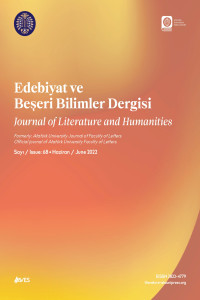Melville’in Moby Dick İsimli Eserinde Karşıtlık: Amerikan Transandantalizmi ile Karşı-Transandantalizm
Balina gemilerinde denizcilik yaparken edindiği deneyimlerden yola çıkan Amerikalı romancı Herman Melville (1819-1891), Moby Dick (1851) isimli başyapıtında insanın denizle ve denizin belirsizlikleri ile olan karmaşık ilişkisini ele alır. Bu amaçla, denizcilik temalı romanında Melville, balina avcısı Kaptan Ahab’ın, bir önceki av sırasasında gemisini tahrip eden ve bacağını dizinden koparan albino sperm balinası Moby Dick’ten intikamını almak için girdiği saplantılı arayışının hikayesini anlatıyor. Ahab gibi bir karakter yaratırken, Melville, insan doğasının kötü, yıkıcı yanını ele almakta ve insan doğasının sınırlamaları ile potansiyel yıkıcılığına odaklanmaktadır. Öte yandan, romanın anlatıcısı Ishmael, roman boyunca Amerikan Transandantalizminin birçok yönünü yansıtmaktadır. Bu nedenle, romanın karşıt iki kahramanı, romanın yapısına da yansımaktadır. Şöyle ki, Ishmael'in romanın ilk bölümünde sergilediği Transandant idealizm ve iyimserlik, kitabın ikinci yarısında yerini Shakespeare trajedisine de uygun olan Ahab’ın intikam takıntısına ve diktacı liderliğine bırakmaktadır. Bu makale Moby Dick isimli eserde Ishmael ve Kaptan Ahab karakterleri aracılığıyla, Amerikan Transandant idealizmi ile Karşı-Transandantalizmin Shakespeare trajedisi formunda nasıl bir arada kullanıldığı göstermeyi amaçlamaktadır.
Anahtar Kelimeler:
Herman Melville, Amerikan Transandantalizmi, Karşı-Transandantalizm, Shakepeare Trajedisi, Karşıtlık
The Dichotomy of Melville’s Moby Dick: American Transcendentalism and Anti-transcendentalism
Counting on his own experiences as a seaman aboard whaling ships, American novelist Herman Melville (1819-1891) comments on the complex human relationship with the sea and its uncertainties in his masterpiece, Moby Dick (1851). To this end, in his maritime novel, Melville tells the story of the obsessive quest of Captain Ahab of the whaler Pequod for revenge on Moby Dick, the albino sperm whale that destroyed his vessel and bit off his leg at the knee on the previous whaling voyage. In creating a character like Ahab, Melville seems to emphasize the evil and destructive side of humanity, focusing on the limitations and potential destructiveness of human nature. On the other hand, the narrator of the novel, Ishmael, displays many aspects of American transcendentalism throughout the novel. Thus, the two opposite protagonists are reflected in the structure of the novel as the transcendental idealism and optimism that Ishmael displays in the early part of the novel are replaced by Ahab’s obsession for revenge and dictatorial leadership in the second half of the book, which is also appropriate for Shakespearean tragedy. This paper seeks to explore how the characters of Ishmael and Captain Ahab in Moby Dick match American transcendental idealism with dark romanticism in the form a Shakespearean tragic plot.
Keywords:
Herman Melville, American Transcendentalism, Anti-transcendentalism, Shakespearean tragedy, Dichotomy,
___
- “American Transcendentalism” (August 30 2019) Digital History..Retrieved from http://www.digitalhistory.uh.edu/disp_textbook_print.cfm?smtid=2&psid= 3551Bryant, J. (1998). “Moby-Dick as Revolution.” The Cambridge Companion to Herman Melville. Robert S. Levine. (Ed). Cambridge: Cambridge UP, pp.65-90.Bloom, H. (2007). Herman Melville’s Moby Dick. Edited and with an introduction by Harold Bloom. New York: Bloom’s Literary Criticism. Elliott, E. (2005). ““Wandering To-and-Fro”: Melville and Religion” in A Historical Guide to Herman Melville. Giles Gunn. (Ed). Oxford: OUP. Emerson, R. W. (2000). The Essential Writings of Ralph Waldo Emerson. Ed.Brooks Atkinson. With and Introduction by Mary Oliver. New York: Modern Library. Hayes, K. J. (2007). The Cambridge Introduction to Herman Melville. Cambridge: CUP. Hughes, R. G. (July 1932). “Melville and Shakespeare,” Shakespeare Association Bulletin, VII, pp. 103-113.Gura, P. F. (2007). American Transcendentalism: A History. New York: Hill and Wang. Klein, B. (Ed) (2002). Fictions of the Sea. Critical Perspectives on the Ocean in British Literature and Culture. Aldershot: Ashgate. Matthiessen, O.F. (1968). American Renaissance: Art and Expression in the Age of Emerson and Whitman. Oxford: OUP. McLoughlin, M. (2003). Dead Letters to the New World: Melville, Emerson and American Transcendentalism. London: Routledge. Melville, H. (2002). Moby Dick. With an introduction by David Herd. Ware: Wordsworth Classics. (Published in 1851)Melville, H. (1988). “Hawthorne and His Mosses” in The Norton Anthology: American Literature. Fifth Edition, Volume 1. Nina Baym. (Ed.) New York: Norton. (Published in 1850)Mills, G. H. (1950). “The Castaway in Moby-Dick” in The University of Texas Studies in English. Vol.29 pp. 231-248. Myers, H. A. (March 1942). “Captain Ahab’s Discovery: The Tragic Meaning of Moby Dick.” The New England Quarterly, Vol. 15. No 1 pp. 15-34.Olson, C. (1947). Call Me Ishmael: A Study of Melville. San Francisco: City Lights Books. Olson, C. (2004). “Shakespeare and Melville” in The American Renaissance. Edited and with an introduction by Harold Bloom. New York: Chelsea House Publishers. Phillips, J. and A. Ladd. (2006). Romanticism and Transcendentalism: 1800-1860. New York: Chelsea House. Reynolds, D. S. (1988). Beneath the American Renaissance: The Subversive Imagination in the Age of Emerson and Melville. Cambridge, Massachusetts: Harvard University Press. Rice, J. C. (Fall 1970). “Moby-Dick and Shakespearean Tragedy” The Centennial Review. Vol. 14. No.4 pp. 444-468. Thompson, L. (1966). Melville’s Quarrel with God. New Jersey: Princeton University Press.
- Yayın Aralığı: Yılda 2 Sayı
- Başlangıç: 1970
- Yayıncı: Atatürk Üniversitesi
Sayıdaki Diğer Makaleler
BİZANS RESİM SANATINDA YANAN ÇALI ÖNÜNDE MUSA’NIN ÇIPLAK AYAK VE SANDALETLERİ
EMÎR HÜSREV-İ DİHLEVÎ’NİN BİR GAZELİNİN İNCELENMESİ
DOÇ. DR. YASEMİN YAYLALI’NIN “KLASİK FARS VE TÜRK ŞİİRİNDE ÇİÇEKLER VE AĞAÇLAR” ADLI ESERİ ÜZERİNE
Ayfer AYDINER BOYLU, Cengiz KILIÇ, Gülay GÜNAY
“SÜRGÜN ÜLKEDEN BAŞKENTLER BAŞKENTİNE” ŞİİRİNE FARKLI BİR BAKIŞ
HİKMET KIVILCIMLI’NIN SOSYOLOJİ ANLAYIŞI: DİYALEKTİK VEYA MADDECİ SOSYOLOJİ
